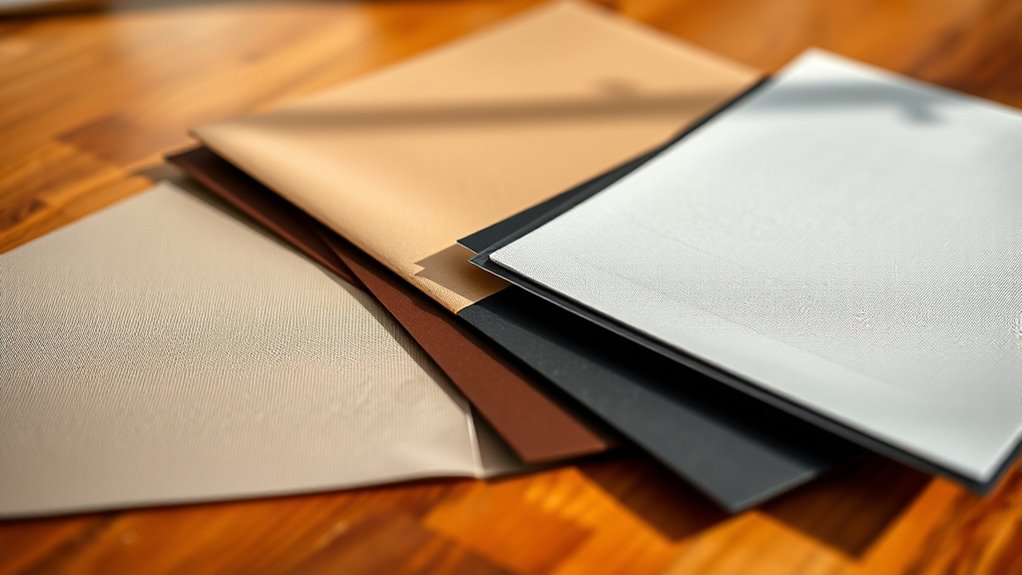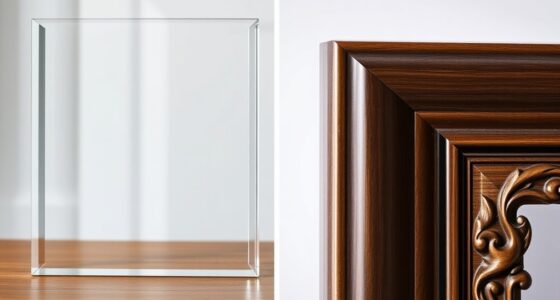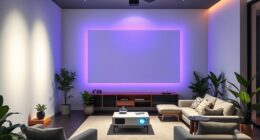Before you start, it’s important to understand the main screen materials like polyester, nylon, and fiberglass, each offering different benefits. Polyester is stable and resistant to shrinking, while nylon provides flexibility and impact resistance. Fiberglass is durable and tear-resistant, ideal for outdoor use. Factors like environmental exposure, impact needs, and weave density influence durability. To choose the best material for your needs, explore the full options and details ahead.
Key Takeaways
- Understand the differences between fiber types (polyester, nylon, fiberglass) and their benefits for durability and environmental resistance.
- Assess your environment (indoor or outdoor) to select the most suitable material based on exposure and wear factors.
- Consider weave density and protective coatings to enhance tear, impact resistance, and lifespan of the screen.
- Evaluate manufacturing quality and fiber integration for consistent performance and longevity.
- Match your specific application needs with the right fiber properties to ensure optimal performance and durability.
Understanding Screen Material Types

Have you ever wondered what makes a screen perform well or last longer? The answer lies in understanding the underlying materials, especially the fiber types used and how they impact screen durability. When choosing a screen material, it’s essential to consider the variety of fibers involved, as these determine the strength, flexibility, and longevity of the product. Different fiber types, such as polyester, nylon, or fiberglass, each offer unique benefits and drawbacks. Polyester fibers are known for their stability and resistance to shrinking, making them suitable for screens that need to withstand frequent handling and exposure to environmental elements. Nylon, on the other hand, offers excellent flexibility and impact resistance, although it may degrade faster under prolonged UV exposure. Fiberglass remains a popular choice because of its exceptional durability and resistance to tearing, which makes it ideal for outdoor screens or high-traffic areas. The integration of advanced automation technologies in manufacturing processes can further improve the consistency and quality of screen materials.
Screen durability is another critical factor to weigh in your decision. The durability of a screen material influences how well it withstands daily wear and tear, weather conditions, and potential accidents. For instance, a fiberglass screen tends to be more resilient against punctures and tears, extending its lifespan and reducing maintenance costs. Conversely, screens made from thinner or less robust fibers might be more prone to damage, especially in demanding environments. It’s also worth considering how the fibers are woven or manufactured, as tightly woven screens tend to be stronger and more resistant to tearing. UV-resistant coatings can further enhance durability, especially for screens exposed to sunlight regularly, helping to prevent fiber degradation over time.
When evaluating screen materials, you should also consider the specific application and environment. For indoor use, a lightweight, flexible fiber like nylon might suffice, providing ease of installation and a clean look. For outdoor settings, durability becomes more critical, making fiberglass or polyester-based screens better options. Additionally, the choice of fiber types can influence the overall clarity and airflow of the screen, impacting your comfort and visibility. The combination of fiber quality, weave density, and protective coatings ultimately determines the lifespan and performance of your screen.
Frequently Asked Questions
Which Screen Material Is Best for Outdoor Use?
For outdoor use, you should choose a screen material with strong UV resistance and breathability. UV-resistant fabrics protect against sun damage and fading, keeping your screen looking fresh longer. Breathability ensures air flows through, preventing moisture buildup and mold. Look for materials like polyester or fiberglass with UV coatings, as they offer durability and comfort. This combination helps your outdoor screen withstand weather elements while maintaining visibility and airflow.
How Does Screen Material Affect Image Clarity?
Think of screen material as the eye of your display; it directly influences your viewing experience. You notice this through image sharpness and material transparency. A high-quality material enhances image clarity by minimizing glare and reducing distortion, allowing for vivid, crisp visuals. Conversely, lower-quality options may dull image sharpness and obscure details. Your choice of material determines how well you see every nuance, making clarity a matter of transparency and precision.
Are There Eco-Friendly Screen Material Options?
Yes, eco-friendly screen materials are available. You can choose options made from biodegradable materials or those with recycling options, reducing environmental impact. Look for screens crafted from sustainable resources like bamboo or recycled plastics, which break down more easily and can be reused or recycled. These options help minimize waste and support eco-conscious choices, ensuring your screen setup is both effective and environmentally responsible.
How Durable Are Different Screen Materials Over Time?
You’ll find that different screen materials vary in durability over time, influenced by UV resistance and thermal stability. Vinyl screens, for example, offer excellent UV resistance, preventing fading and cracking, while polyester screens excel in thermal stability, resisting warping from heat. Over years, these features help maintain your screen’s integrity and appearance. Regular maintenance, like cleaning and protective coatings, can further extend their lifespan, ensuring your screen stays durable and effective.
Can Screen Materials Be Customized for Specific Projects?
Ever thought about customizing your screen materials for specific projects? You absolutely can! With options like flexible materials and various textures, you can tailor screens to your needs. While customization offers great versatility, remember to consider material flexibility and cost considerations. Are you willing to invest a bit more for a perfect fit? Customizing allows you to match project requirements precisely, ensuring ideal performance and results tailored to your unique needs.
Conclusion
Choosing the right screen material is vital for peak display quality. For example, imagine installing a matte screen in a bright conference room—it reduces glare and enhances visibility, making meetings more productive. Remember, understanding your environment and needs guarantees you pick the best material. Take the time to evaluate options carefully; your viewing experience depends on it. Ultimately, the right choice transforms your space and keeps your visuals crisp and clear every time.









